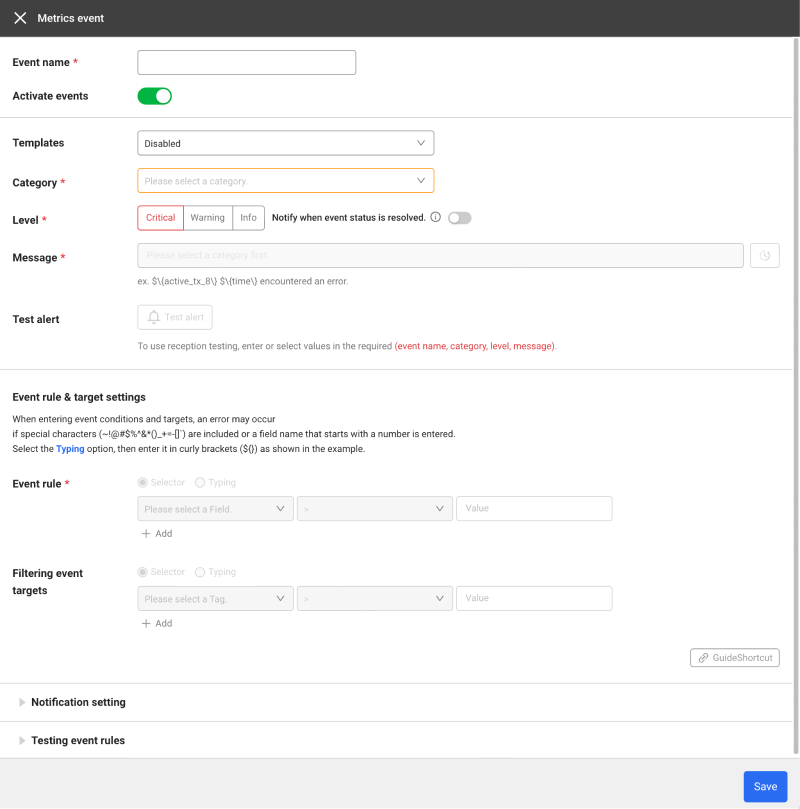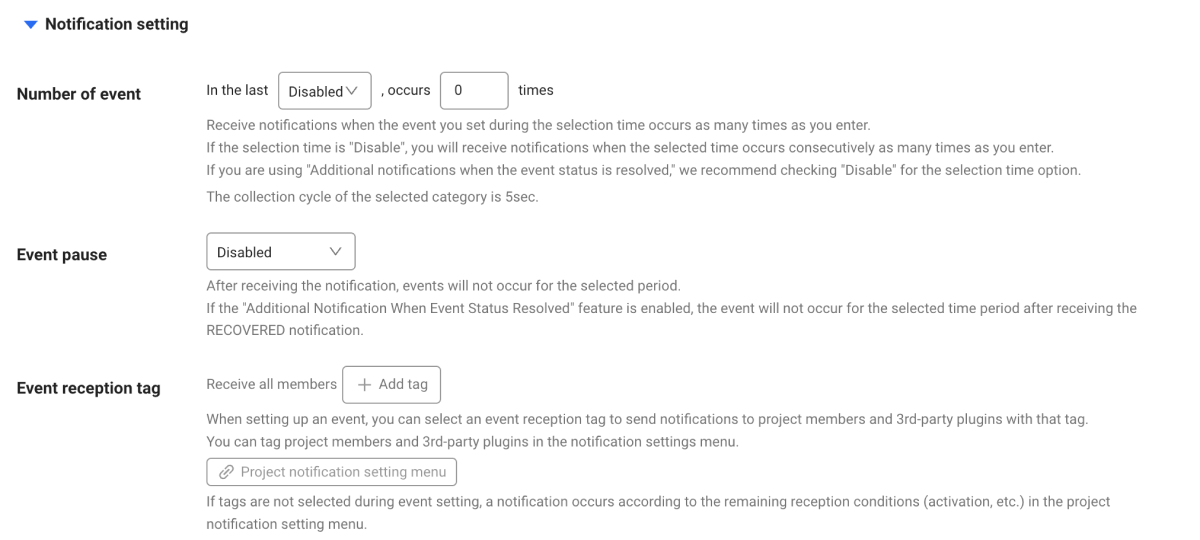Metrics alert
Home > Select Project > Alert > Event configuration
What is the metrics event?
Metrics events are used to set more specific and complex events than basic events (application events, server events, and such). You can set events based on the metrics data being collected in real time from your projects.
-
For more information about the metrics, see the following.
-
You can add metrics events from the Event Configuration
Newmenu, which has a new UI for improved usability. For more information, see the following. -
This feature is only available to the members with the Alert settings role. For more information about member roles, see the following.
Metrics Event
In Alert > Event configuration, select Add Alert Policy on the upper right of the screen. The Metrics event window appears.

Entry of basic information
-
Event name: Enter the name of the event to add.
-
Activate events: Select whether or not to activate events.
-
Templates: Events can be easily set after selecting a template. If the template is not to be used, select Disabled.
NoteFor more information about the template list, see the following.
-
Category: The unit to identify the metrics data. It is a mandatory value for setting the metrics events.

-
The Category selection options display
 Name and
Name and  data collection interval, and
data collection interval, and  Key. When setting up an event, use the key value of the category.
Key. When setting up an event, use the key value of the category. -
Category retrieves metrics data being collected from projects within the last 3 hours and displays them in a list. If the collection interval is not displayed in the Category selection options, you can select Enter it yourself option to enter a category key.
-
-
Level
-
It displays the alert level when an event occurs. The levels are Critical, Warning, and Info. When setting the Critical and Warning levels, the Additional notifications when the event state is resolved. selection option is enabled.
-
Additional notifications when the event state is resolved.: You can choose whether to send Additional notifications when the event state is resolved. that occurred among events. You can turn the feature on or off by selecting the toggle button.
-
-
Message
-
Enter a notification message to be displayed when events occur. By entering
${Tag}or${Field}, you can apply the variable to the message. The key to enter in the variable must be included in Category of the selected metrics data. You can see the tags or field keys that can be entered in Metrics Search.
-
If the
button is clicked, you can see the history of previously entered messages.
-
-
Test alert
By generating alerts based on the required items: Event name, Category, Level, and Message, this function checks the messages.
Note-
During testing, substitutions for actual metric values or variables do not work.
-
The Event reception option sends test notifications only to users with the recipient tag set. If Receive all is selected, the test notifications are sent to all users.
-
To use a reception test, enter or select required items in Event name, Category, Level, and Message.
-
-
Event rule

By entering the
field,
operator selection, and
threshold value, set the event rule.
-
Filtering event targets

It filters the targets by entering the
tag,
operator selection, and
filtering value. If no input, alerts are sent to all agents.
-
For available basic syntaxes and operators in Event rule and Filtering event targets, see the following.
-
For the Event rule and Filtering event targets options, you can select Selector or Typing.
-
After the event setting is made, the option value is managed as the Typing option. Afterwards, if switched to the Selector option, the option value can be initialized.
-
Upon entry of event occurrence conditions and targets, an error may occur, if you enter a field name that contains special characters (
~!@#$%^&*()_+=-[]`) or begins with a number. In this case, select the Typing option and then enter values enclosing with curly brackets (${}) as shown in the following example:${4xxErrorType} == '401'
Notification setting

-
Number of event: For the selected period, if the events set in Event rule occur as many as the input, an alert is sent.
Note- If the selected time is set to Disabled, an alert is sent only when the events occur consecutively as many as the input.
- If the option, Additional notifications when the event state is resolved. is activated, it is recommended to select Disabled as the selected time.
- In the Category option, the collection cycle for the selected item is 5 seconds.
-
Event pause: This option can prevent excessive alert notifications from happening. No alerts are sent for the selected period after the first alert notification is generated. In addition, they are not recorded in Event history.
-
Related category: You can set the related categories up to 5 and see them when checking notifications.
-
Event reception tag: If this tag is selected, notifications can be sent to project members and 3rd-party plug-ins with the corresponding tags. If the event receiving tag is not selected, alerts are sent to all project members.
NoteIn Alert > Notification setting, you can set the tags in project members and 3rd-party plug-ins.
Testing event rules

You can check how many alerts have occurred by enabling the event conditions you set for the selected time period. If your select RUN, the number of notifications occurred appears in the upper right corner. The selected field and thresholds are displayed on the chart in Event rule.
-
For more information about Event rule, see the following.
-
The Testing event rules feature can test for the data for 24 hours.
Modifying and deleting metrics events
-
Go to Alert > Event configuration.
-
In the event list, select
at the utmost right of the item to modify or delete.
-
If the metrics event setting window appears, modify each option and then select Save.
To delete the selected event, select
Delete on the upper right of the event setting window.
Guide to select generation conditions and targets
For the event generation conditions and selection of event targets on metrics alerts, use the same syntaxes. For event generation conditions, use the tag key as a variable. For selection of event targets, use the field key as a variable.
Basic syntax rules
-
If you just enter a string, it is recognized as a variable. If you enclose it in single quotation marks ('') or double quotation marks (""), it is recognized as text.
oid == "oid"1. oid: variable
2. ==: function
3. "oid": text// In case oname is ott-1235
// Normal cases
onname = 'ott-1235' or onname = "ott-1235"
// In abnormal cases, notification does not work.
onname = ott-1235 -
If you just enter a number, it is recognized as number, and if you enclose it in single quotation marks ('') or double quotation marks (""), it is recognized as text.
oid == 1231. oid: variable
2. ==: function
3. 123: number// In case oid is 123
// Normal cases
oid = 123
// In abnormal cases, notification does not work.
id == '123' or oid == "123"
List of available operators
| Operator | Usage | Description |
|---|---|---|
== | operand1 == operand2 | It checks whether operand1 is equal to operand2. |
!= | operand1 != operand2 | It checks whether operand1 and operand2 have different values. |
> | operand1 > operand2 | Check whether the operand1 value is greater than the operand2 value. |
>= | operand1 >= operand2 | Checks whether the operand1 value is greater than or equal to the operand2 value. |
< | operand1 < operand2 | Check whether the operand1 value is less than the operand2 value. |
<= | operand1 <= operand2 | Check whether the operand1 value is less than or equal to the operand2 value. |
like | operand1 like operand2 | Search with patterns whether operand1 includes operand2. |
&& | expression1 && expression2 | Check whether expression1 and expression2 are all true. |
and | expression1 and expression2 | Check whether expression1 and expression2 are all true.The operator plays the same role as &&. |
|| | expression1 || expression2 | Check whether expression1 and expression2 are all true. |
or | expression1 or expression2 | Check whether expression1 and expression2 are all true.The operator plays the same role as ||. |
Usage of like
You can conveniently search for embedded strings via the wildcard (*).
-
Searching for strings that start with a specific keyword
Key like "Value*" -
Searching for strings that end with a specific keyword
Key like "*Value" -
Searching for strings that include a specific keyword
Key like "*Value*" -
The wildcard (
*) cannot be used in the middle of keywords.
// Unsupported syntax
Key like "Va*lue" -
If you omit the wildcard (
*) in thelikeoperator, it operates as equals (==).
// The following two statements have the same result.
Key like "Value"
Key == "Value"
Available functions
| Method | Usage | Description |
|---|---|---|
| startsWith | startsWith(param1, param2) | If the value whose param1 is the key starts with param2, the result is true. Otherwise, the result is false. |
| endsWith | endsWith(param1, param2) | If the value whose param1 is the key ends with param2, the result is true. Otherwise, the result is false. |
| isNull | isNull(param1) | If param1 is null, the value becomes true. Otherwise, the value becomes false. |
| isNotNull | isNotNull(param1) | If param1 is not null, the value becomes true. Otherwise, the value becomes false. |
| isEmpty | isEmpty(param1) | If param1 is null or EmptyString(""), the value becomes true. Otherwise, the value becomes false. |
| isNotEmpty | isNotEmpty(param1) | If param1 is not null nor EmptyString(""), the value becomes true. Otherwise, the value becomes false. |
startsWith
startsWith(Key, "Value")
endsWith
endsWith(Key, "Value")
isNull
isNull(Key)
isNotNull
isNotNull(Key)
isEmpty
isEmpty(Key)
isNotEmpty
isNotEmpty(Key)
Template
In Alert > Event Configuration, select + Add Alert Policy. Select a desired item in Templates. The alert templates are provided as follows.
-
Network jitter alert
It sends this alert when the average jitter(
avg_jitter) exceeds 30 ms. -
Network latency warning
If the average latency(
avg_latency) exceeds 200 ms, this alert is sent. -
Data transfer warning
If the data transmission amount (bps) exceeds 128 Mib/s, this alert is sent.
-
Packet traffic warning
If the packet transmission amount (pps) exceeds 50 Kpps, this alert is sent.
-
Session aggregate warning
If the aggregated session count (
session_count) is greater than 100, this alert is sent.